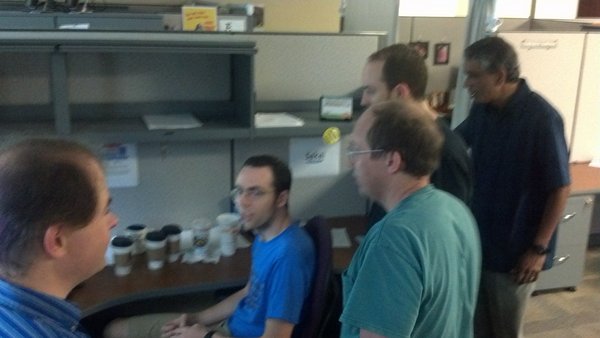Welcome to thatlinuxbox.com Saturday, July 05 2025 @ 07:09 PM UTC
Six SysAdmins
- Thursday, May 17 2012 @ 12:38 AM UTC
- Contributed by: Dan Stoner
- Views: 3,368

- Comments (0)
Standing Workstation v2.0
- Wednesday, January 25 2012 @ 03:03 AM UTC
- Contributed by: Dan Stoner
- Views: 6,050
I've been tweaking my desk area and this is where I am today, version 2.0 of my standing workstation:

The upper LCD shelf is made from a cheap melamine shelf with CAPITA legs from IKEA. So far it is working well, and the third LCD monitor is a nice addition.
- Comments (0)
Standing Workstation v1.0
- Tuesday, September 20 2011 @ 01:54 AM UTC
- Contributed by: Dan Stoner
- Views: 12,134

There are also articles that report on the dangers of sitting too much.
I have certainly noticed that I feel better when I do not sit behind my computer all day. Most importantly I am not as stiff and have fewer aches and pains. I have been using Workave software for a while to remind me to stand up and take a break from sitting.
Taking this idea to the next level, I now have a standing workstation at my work cube. Our particular office furniture is somewhat modular and it was not too difficult to raise a portion of the work surface. There are other folks around here who have raised the entire work surface but I kind of like the terraced approach. With the new standing workstation, I can now sit down when it is time to take a break. Imagine that.
This is a photo of version 1.0 of my standing workstation, still in progress:
- read more (262 words)
- Comments (0)
New Job - System Admin with the CNS Open Systems Group at UF
- Tuesday, August 30 2011 @ 03:23 PM UTC
- Contributed by: Dan Stoner
- Views: 6,526
I will be doing mostly Linux System Administration in support of many University-wide services, probably specializing in the Linux web hosting area. This is pretty cool for me since it is right in line with my interests.
My office is no longer on the main campus but is now over on Waldo Rd. at the new Eastside campus.
Here is a picture of the building:

Somehow I managed to land in the corner cubby. I like the layout of the office space. The cubes surround tables / work areas which seems to be effective at facilitating team communication. I'm learning a lot just by sitting in proximity to the team lead.

After spending just a few days with the OSG team, I am pleased with the personality of the group. I feel like I will be a good fit.
Looking forward to everything that comes next!
- Comments (0)
Nice Apron
- Wednesday, April 27 2011 @ 07:40 PM UTC
- Contributed by: Dan Stoner
- Views: 4,190

- Comments (0)








 Twitter
Twitter
 LinkedIn
LinkedIn
 GitHub
GitHub


